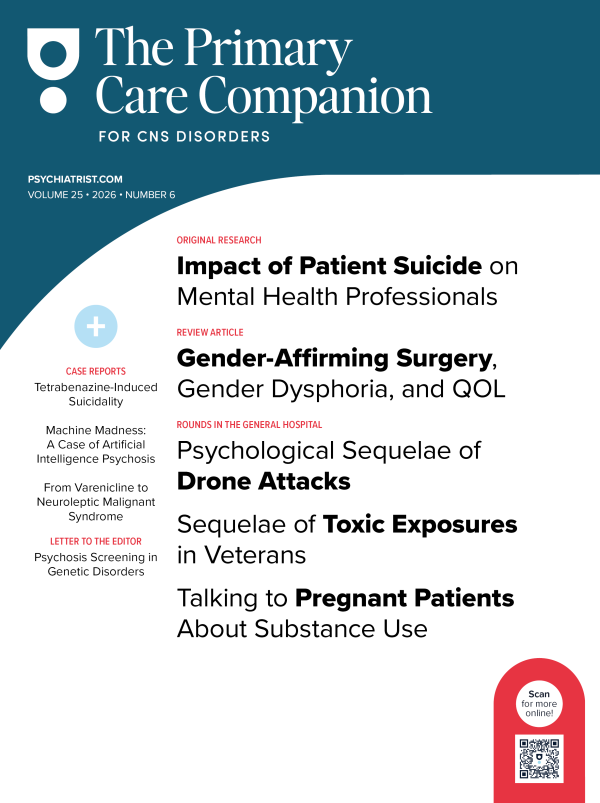Because this piece does not have an abstract, we have provided for your benefit the first 3 sentences of the full text.
To the Editor: Bupropion is an antidepressant that has been reported to induce various extrapyramidal tract symptoms in patients with mood disorders. Previous reports typically involved older patients or those with concurrent physical illness. In contrast, the association between bupropion and dyskinesia has yet to be reported in younger patients with no major physical comorbidities.
Bupropion-Induced Dyskinesia in a Young Adult Patient With Bipolar Disorder
To the Editor: Bupropion is an antidepressant that has been reported to induce various extrapyramidal tract symptoms in patients with mood disorders.1-6 Previous reports1-6 typically involved older patients or those with concurrent physical illness. In contrast, the association between bupropion and dyskinesia has yet to be reported in younger patients with no major physical comorbidities. Here, we present the case of a young adult who developed dose-dependent dyskinesia while taking bupropion for treatment of bipolar depression.
Case report. Ms A is a 30-year-old woman who received a diagnosis of bipolar II disorder at the age of 23 years. She reported no past history of major medical disease or substance abuse behavior. She had no family history of neurologic diseases.
Ms A had received regular treatment in the clinic of a university hospital since the age of 27 years. She experienced a depressive episode at the age of 29 years, which was not fully remitted even after several psychotropic regimens, including the combined therapy of lithium 600 mg/d, escitalopram 20 mg/d, and aripiprazole 15 mg/d. Therefore, bupropion 150 mg/d was started in June 2016 to replace escitalopram for the treatment of bipolar depression. Meanwhile, aripiprazole was discontinued. After 2 weeks, the bupropion dosage was increased to 300 mg/d. Because the depressive symptoms were gradually alleviated, treatment with bupropion 300 mg/d and lithium 600 mg/d was continued. After 3 months of treatment with bupropion 300 mg/d, Ms A began to develop involuntary movements, including intermittent chewing, lip pouting, tongue writhing, eye blinking, neck twisting, and pelvic gyrations. These dyskinetic movements increased with anxiety, decreased with relaxation, and disappeared during sleep. Her total score on the Abnormal Involuntary Movement Scale7 was 26. Ms A was referred to a neurologist’s clinic in the same hospital for management of the dyskinesia. Results of brain MRI and blood tests, including a biochemistry screen for Wilson disease, were unremarkable. Therefore, bupropion-induced dyskinesia was clinically suspected. After the bupropion dosage was reduced from 300 mg/d to 150 mg/d for 2 months, Ms A’s AIMS score decreased to 5.
To the best of our knowledge, this report is the first to demonstrate the temporal relationship between dyskinesia and bupropion use in a young adult with no concurrent physical illness. Currently, the mechanisms for the association between dyskinesia and bupropion use are not fully elucidated. Studies have suggested that bupropion is an antidepressant that acts as a dopamine reuptake inhibitor.8 Elevated synaptic dopamine levels in the basal ganglia may lead to dyskinesia that resembles prodopaminergic agent-induced dyskinesia.9 However, tools such as positron emission tomography were not used in this case to confirm our hypothesis. In addition, our observations of the association between dyskinesia and bupropion use in this case cannot be reexamined because of ethical considerations. Consequently, additional case studies applying imaging tools for exploring the changes of occupancy in dopamine receptor or transporter are warranted to validate our observations.
In this case, the total score on the Naranjo Adverse Drug Reaction Probability Scale10 was 3 (ie, the possible category). Therefore, diagnoses other than bupropion-induced dyskinesia should be differentiated. Meige syndrome is a kind of cranial dystonia that can be associated with different types of involuntary movements including facial dyskinesia. Although the pathogenesis of most cases is unknown, Meige syndrome was found to be related to the use of antidepressants in some patients.11 Considering that approximately half of patients with Meige syndrome have progressive symptoms spreading to cervical and limb muscles within 5 years of illness onset,11 we should therefore carefully follow up the clinical course of the present case, particularly after the reduction of bupropion dosage.
Despite its limitations, this case is informative because the dyskinetic movements emerged after the bupropion dosage was increased from 150 to 300 mg/d and were subsequently alleviated after the bupropion dosage was reduced to 150 mg/d. These observations suggest that bupropion-induced dyskinesia is very likely to be dose dependent. Furthermore, an early reduction of bupropion dosage may possibly reverse the dyskinesia. Given that early diagnosis and intervention are important, this case reminds clinicians to be aware of this adverse effect among patients, even those with younger age and generally good physical health.
References
1. Szuba MP, Leuchter AF. Falling backward in two elderly patients taking bupropion. J Clin Psychiatry. 1992;53(5):157-159. PubMed
2. Strouse TB, Salehmoghaddam S, Spar JE. Acute delirium and parkinsonism in a bupropion-treated liver transplant recipient. J Clin Psychiatry. 1993;54(12):489-490. PubMed
3. Gardos G. Reversible dyskinesia during bupropion therapy. J Clin Psychiatry. 1997;58(5):218. PubMed CrossRef
4. de Graaf L, Admiraal P, van Puijenbroek EP. Ballism associated with bupropion use. Ann Pharmacother. 2003;37(2):302-303. PubMed CrossRef
5. Cheng WC, Liu CM, Hsieh MH, et al. Bupropion-related parkinsonism and dystonia. J Clin Psychopharmacol. 2009;29(6):616-618. PubMed CrossRef
6. Kayhan F, Uguz F, Kayhan A, et al. Bupropion XL-induced motor and vocal tics. Clin Neuropharmacol. 2014;37(6):192-193. PubMed CrossRef
7. Guy E. Abnormal Involuntary Movement Scale. National Institute of Mental Health, Assessment Manual for Psychopharmacology. Rockville, MD: US Department of Health and Human Services; 1976.
8. Ascher JA, Cole JO, Colin JN, et al. Bupropion: a review of its mechanism of antidepressant activity. J Clin Psychiatry. 1995;56(9):395-401. PubMed
9. Damier P. Drug-induced dyskinesias. Curr Opin Neurol. 2009;22(4):394-399. PubMed CrossRef
10. Naranjo CA, Busto U, Sellers EM, et al. A method for estimating the probability of adverse drug reactions. Clin Pharmacol Ther. 1981;30(2):239-245. PubMed CrossRef
11. Pandey S, Sharma S. Meige’s syndrome: history, epidemiology, clinical features, pathogenesis and treatment. J Neurol Sci. 2017;372:162-170. PubMed CrossRef
aDepartment of Psychiatry, Taipei Medical University Hospital, Taipei, Taiwan
bDepartment of Psychiatry, School of Medicine, College of Medicine, Taipei Medical University, Taipei, Taiwan
Potential conflicts of interest: None.
Funding/support: None.
Additional information: Information has been de-identified to protect patient anonymity.
Published online: November 16, 2017.
Prim Care Companion CNS Disord 2017;19(6):17l02128
https://doi.org/10.4088/PCC.17l02128
© Copyright 2017 Physicians Postgraduate Press, Inc.
Please sign in or purchase this PDF for $40.00.





